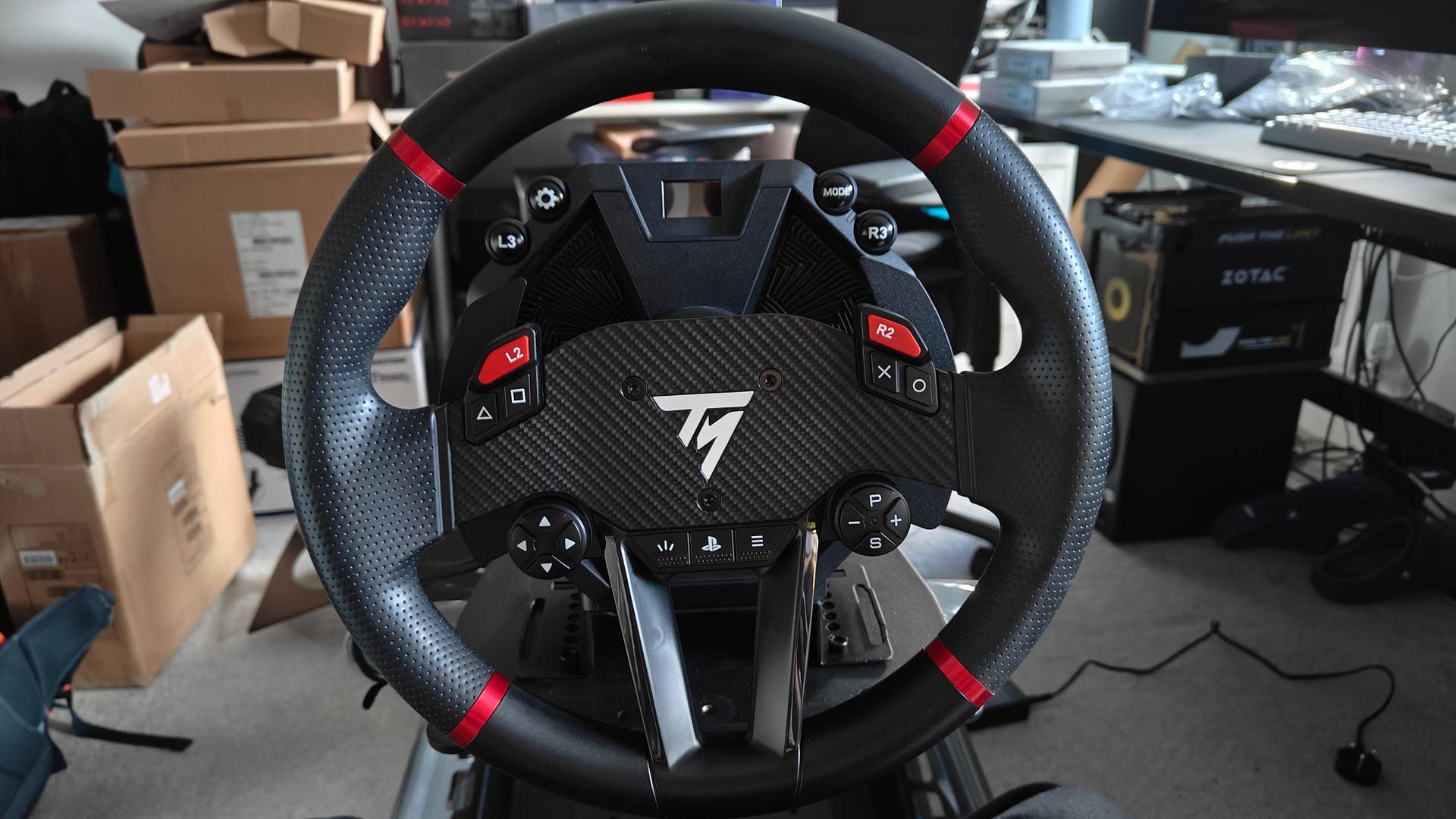Thrustmaster T598 + Hypercar Wheel review: a great value PC/PS5 sim racing wheel and pedals built on novel tech
Thrustmaster T598 + Hypercar Wheel review: a great value PC/PS5 sim racing wheel and pedals built on novel tech
Direct axial drive impresses, despite limited software and a firmly mid stock wheel.
Image credit: Digital Foundry
Review
by Will Judd
Deputy Editor, Digital Foundry
Published on June 1, 2025
We've seen an explosion in the number of affordable direct driveracing wheels over the past couple of years, with Fanatec and Moza offering increasingly inexpensive options that still deliver the precise, quick and long-lasting force feedback that cheaper gear- or belt-driven wheels can't match.
Now, Thrustmaster is intruding on that territory with the T598, a PlayStation/PC direct drive wheel, wheel base and pedals that costs just £449/That's on a similar level to the PC-only £459/Moza R5 bundle and the €399/Fanatec CSL DD bundle, so how does the newcomer compare? And what's changed from the more expensive T818 we reviewed before?
We've been testing the T598 - and the fancy upgraded HyperCar wheel that's available as an upgrade option - for weeks to find out. Our full review follows, so read on - or check out the quick links below to jump to what you're most interested in.
To see this content please enable targeting cookies.
Thrustmaster T598 wheel base review: direct axial drive vs traditional direct drive
Interestingly, the T598 arguably comes with a more advanced DD motor than the more expensive T818 does. It uses a "direct axial drive" versus the standard "direct radial drive", where the magnets are aligned parallel to the wheel shaft rather than perpendicular. This ought to allow for more efficient torque generation, producing less waste heat, minimising precision-sapping magnetic interference and requiring less copper to produce. It also means the T598 can "overshoot" to deliver more than its rated 5nm of constant torque for short periods.
However, this design also requires a physically taller yet slimmer enclosure, potentially blocking the view forward and requiring a different bolt pattern to attach the base to your desk or sim racing cockpit - both of which are slight annoyances with the T598.Interestingly, you can also feel a slight vibration and hear a quiet crackling noise emanating from the T598 base while idle - something I haven't heard or felt with other direct drive motors and is reportedly inherent to this design.
There's a lot going on inside this wheel base - including some genuine innovation. | Image credit: Thrustmaster/Digital Foundry
Thrustmaster has written a pair of white papers to explain why their take on direct driveis better than what came before. Image credit: Thrustmaster
In terms of the force feedback itself, Thrustmaster have achieved something quite special here. In some titles with a good force feedback implementation - Assetto Corsa, Assetto Corsa Evo and F1 23 stood out to me here - the wheel feels great, with strong force feedback and plenty of detail. If you run up on a kerb or start to lose traction, you know about it right away and can take corrective action. I also appreciated the way that turning the wheel feels perfectly smooth when turning, without any cogging - the slightly jerky sensation common to low-end and mid-range direct drive motors that corresponds to slight attraction as you pass each magnet.
However, balancing this, the wheel's force feedback feels a little less consistent than others I've tested from the likes of Fanatec or Moza at a similar price point, with some games like Project Cars 3 and Forza Motorsport feeling almost bereft of force feedback by comparison. You also have that slight vibration when the wheel is stationary, which is potentially more noticeable than the cogging sensation in traditional DD designs. The overshoot is also a mixed bag - as the sudden jump in torque can feel a little artificial in some scenarios, eg when you're warming your tyres by weaving in F1 before a safety car restart.
I'd say that these positives and negatives largely cancel each other out, and you're left with force feedback that is good, way better than non-DD wheels, but not noticeably better than more common radial direct drive designs. Depending on the games you play, either DD style could be preferable. It'll be interesting to see if Thrustmaster are able to tune out some of these negative characteristics through firmware updates - or simply in later products using the same technology.
1 of 7
Caption
Attribution
Here's how the T598 looks IRL - from the wheel base itself to the default rim, the upgraded Hypercar wheel and the included dual pedals. Click to enlarge.
Apart from the novel motor, the rest of the wheel base is fairly standard - there's a smalldisplay on the top for adjusting your settings and seeing in-game info like a rev counter, four large circular buttons buttons, the usual Thrustmaster quick release lock for securing your wheel rim and a small button on the back to turn the wheel base on and off. There are connection options for power, USB and connecting other components like pedals or shifters on the back too.
Weirdly, there's no ability to change settings in the PC Thrustmaster Panel app - it just says this functionality is "coming soon!" - so right now you can only use it for updating firmware, testing buttons and changing between profiles.
"Coming soon!" starts to become a little less believable six months after the first reviews hit. | Image credit: Digital Foundry
Instead, you'll be using the built-in screen for making changes, which works well enough but doesn't provide any allowance for extra information - so you'll be sticking to the four basic pre-made profiles, referring to the manual or checking suggested setups online rather than reading built-in tool tips.
You still get access to the full whack of settings here, and of course this works well for PS5/PS4 users who wouldn't expect a software experience anyway, but PC users may be disappointed to learn that there's no intuitive software interface here. I found the Boosted Media YT review of the wheelbase to offer some good insight into what settings you're likely to want to change from their default values.
Thrustmaster T598 Sportcar wheel review: a workable default option
The Sportcar wheel rim looks good - but a plastic construction and relatively spartan controls make it "OK" at best.
The "Sportcar" wheel provided in the bundle is a little less impressive-looking than the base itself, with a plasticky feel throughout and fairly mushy buttons - though the paddles are snappy enough and feel good to use. The usual PS-style face buttons are split into two clumps up top with L2 and R2, which is a bit odd, with four individual directional buttons in the lower left, start/select/PS in the lower middle and four configuration buttons in the lower right.
Those configuration buttons require extra explanation, so here we go: the P button at the top swaps between four different pages, indicated with a different colour LED, allowing the remaining three physical buttons to activate up to 12 different functions.There are no rotary encoders or other additional controls here, so PC players that prefer more complicated racing sims may feel a bit underserved by this clunky, cost-saving solution.
The 815g wheel is at least sized reasonably, with 300mm circular shape that particularly suits drifting, rally and trucking - though all forms of driving and racing are of course possible. The rubber grips under your hands are reasonably comfortable, but you can still feel seams in various places. Overall, the wheel is possibly the weakest part of the package, but perfectly usable and acceptable for the price point.
Thrustmaster Hypercar Wheel Add-On review: true luxury
An incredible wheel with premium materials, excellent controls and a more specialised shape.
Thrustmaster also sent over the £339/Hypercar wheel rim for testing, which is an upgrade option that uses significantly better materials - leather, alcantara, aluminium and carbon - and offers a huge number of extra controls. Its oval shape feels a bit more responsive for faster vehiclesthat require a quick change of direction, but drifting and rally doesn't feel natural. It supports the same PS4, PS5 and PC platforms as the stock option, but there are no legends printed on the buttons to help you.
The difference in quality here is immediately apparent, with much better tactile feedback from the buttons and a huge number of additional controls for adjusting stuff like ERS deployment or brake bias. Each control feels well-placed, even if the T-shaped layout for the face buttons is slightly unnatural at first, and the paddles for shifting and the clutch are particularly well engineered. I also found holding the wheel a bit more comfortable thanks to that flattened out shape, the more premium materials and the absence of bumps or seams anywhere you're likely to hold.
It's a huge upgrade in terms of feel and features then, as you'd hope for a wheel rim that costs nearly as much as the entire T598 kit and caboodle. As an upgrade option, I do rate it, though it perhaps makes slightly more sense for T818 owners that have already invested a bit more in the Thrusmaster ecosystem. Regardless, it was this rim that I used for the majority of my time with the T598, and the wheel base feels significantly better with the upgrade.
Thrustmaster T598 Raceline pedals review: great feedback, but no clutch and no load cell upgrade offered at present
Surprisingly good for two add-in pedals, in terms of feedback and flexibility.
The pedals that come with the T598 are surprisingly good, with an accelerator, a brake pedaland no clutch pedal. Each pedal's spring assembly can be pushed into one of three positions to change the amount of pre-load - ie make it a bit softer or harder to press and the pedal plates can be shifted up and down. The narrow dimensions of the metal wheel plate meant that it was impossible to mount directly in the centre of the Playseat Trophy I used for testing, but the slightly off-centre installation I ended up with still worked just fine. They connect using a non-USB connection, so you can't use the pedals with other wheel bases.
Using the middle distance setting and the firmer of the two springs for the brake, I found the T598 produced good results, on par or perhaps even a tad better than other metal-construction Hall Effect position sensorpedals I've tested such as the Moza SR-P Lite and Fanatec CSL. Braking is the critical point here, as you want to be able to feel when the brake has mechanically reached its threshold and then modulate your inputs from there, and the T598 pedals do allow for this quite easily. They're also not so hard to actuate that you end up having to hard-mount them to a sim rig for good results, and the included carpet spikes are reasonably effective in keeping the pedals in place.
Presumably, it ought to be possible to add on a load cell brake pedal down the line to upgrade to a properthree pedal setup. For the F1 style driving that I prefer, the clutch pedal isn't used anyway, so it wasn't a massive issue for me - and we frequently see companies like Moza and Fanatec drop the clutch pedal on these aggessively priced bundles so Thrustmaster aren't losing ground by following suit.
Thrustmaster T598 final verdict: a competitive £450 package with potential
For PlayStation owners, this is an incredible value pickup that ranks among the cheapest DD options - and PC owners ought to consider it too.
For £449/the Thrustmaster T598 is an excellent value direct drive wheel and pedal bundle for PlayStation and PC with some relatively minor quirks. The wheel base is powerful, detailed and responsive in most games, with some advantages over traditional DD designs but also some disadvantages - notably the taller shape and a slight hum/vibration while stationary. Traditional DD designs from the likes of Fanatec and Moza can offer more reliable force feedback that works over a wider range of games, cars and tracks, while also benefitting from better PC software, but there's certainly potential for Thrustmaster to improve here.
The included wheel feels a bit cheap, with a predominantly plastic design, spongey buttons and a slightly odd layout, but the full circle shape and full PS5/PS4 compatibility is most welcome. Upgrading to the HyperCar wheel provides a huge uptick in materials, tactile feedback and number of controls, though this does come at a fairly steep price of £339/If you plan to use the T598 for years and have the budget for it, this is a super upgrade to aim for.
The included Raceline LTE pedals are the most surprising element for me. These consist of only an accelerator and a brake with only moderate adjustability and a narrow base plate, but they feel great to use, are made from durable metal with HE sensors, and only really lose out to significantly more expensive load cell options. For an add-in for a relatively cheap DD bundle, they're a solid inclusion, and I hope Thrustmaster release a load cell brake pedal for users to upgrade to a better three-pedal setup later.
Overall, it's an competitive first outing for Thrustmaster with the T598 and direct axial drive, and I'm curious to see where the company - and the tech - goes from here. With Fanatec still on the rebuild after being acquired by Corsair and Moza's offerings being hard to order online in some regions, Thrustmaster has a golden opportunity to seize a share of the mid-range and entry-level sim racing market, and the T598 is a positive start.
#thrustmaster #t598 #hypercar #wheel #reviewThrustmaster T598 + Hypercar Wheel review: a great value PC/PS5 sim racing wheel and pedals built on novel tech
Thrustmaster T598 + Hypercar Wheel review: a great value PC/PS5 sim racing wheel and pedals built on novel tech
Direct axial drive impresses, despite limited software and a firmly mid stock wheel.
Image credit: Digital Foundry
Review
by Will Judd
Deputy Editor, Digital Foundry
Published on June 1, 2025
We've seen an explosion in the number of affordable direct driveracing wheels over the past couple of years, with Fanatec and Moza offering increasingly inexpensive options that still deliver the precise, quick and long-lasting force feedback that cheaper gear- or belt-driven wheels can't match.
Now, Thrustmaster is intruding on that territory with the T598, a PlayStation/PC direct drive wheel, wheel base and pedals that costs just £449/That's on a similar level to the PC-only £459/Moza R5 bundle and the €399/Fanatec CSL DD bundle, so how does the newcomer compare? And what's changed from the more expensive T818 we reviewed before?
We've been testing the T598 - and the fancy upgraded HyperCar wheel that's available as an upgrade option - for weeks to find out. Our full review follows, so read on - or check out the quick links below to jump to what you're most interested in.
To see this content please enable targeting cookies.
Thrustmaster T598 wheel base review: direct axial drive vs traditional direct drive
Interestingly, the T598 arguably comes with a more advanced DD motor than the more expensive T818 does. It uses a "direct axial drive" versus the standard "direct radial drive", where the magnets are aligned parallel to the wheel shaft rather than perpendicular. This ought to allow for more efficient torque generation, producing less waste heat, minimising precision-sapping magnetic interference and requiring less copper to produce. It also means the T598 can "overshoot" to deliver more than its rated 5nm of constant torque for short periods.
However, this design also requires a physically taller yet slimmer enclosure, potentially blocking the view forward and requiring a different bolt pattern to attach the base to your desk or sim racing cockpit - both of which are slight annoyances with the T598.Interestingly, you can also feel a slight vibration and hear a quiet crackling noise emanating from the T598 base while idle - something I haven't heard or felt with other direct drive motors and is reportedly inherent to this design.
There's a lot going on inside this wheel base - including some genuine innovation. | Image credit: Thrustmaster/Digital Foundry
Thrustmaster has written a pair of white papers to explain why their take on direct driveis better than what came before. Image credit: Thrustmaster
In terms of the force feedback itself, Thrustmaster have achieved something quite special here. In some titles with a good force feedback implementation - Assetto Corsa, Assetto Corsa Evo and F1 23 stood out to me here - the wheel feels great, with strong force feedback and plenty of detail. If you run up on a kerb or start to lose traction, you know about it right away and can take corrective action. I also appreciated the way that turning the wheel feels perfectly smooth when turning, without any cogging - the slightly jerky sensation common to low-end and mid-range direct drive motors that corresponds to slight attraction as you pass each magnet.
However, balancing this, the wheel's force feedback feels a little less consistent than others I've tested from the likes of Fanatec or Moza at a similar price point, with some games like Project Cars 3 and Forza Motorsport feeling almost bereft of force feedback by comparison. You also have that slight vibration when the wheel is stationary, which is potentially more noticeable than the cogging sensation in traditional DD designs. The overshoot is also a mixed bag - as the sudden jump in torque can feel a little artificial in some scenarios, eg when you're warming your tyres by weaving in F1 before a safety car restart.
I'd say that these positives and negatives largely cancel each other out, and you're left with force feedback that is good, way better than non-DD wheels, but not noticeably better than more common radial direct drive designs. Depending on the games you play, either DD style could be preferable. It'll be interesting to see if Thrustmaster are able to tune out some of these negative characteristics through firmware updates - or simply in later products using the same technology.
1 of 7
Caption
Attribution
Here's how the T598 looks IRL - from the wheel base itself to the default rim, the upgraded Hypercar wheel and the included dual pedals. Click to enlarge.
Apart from the novel motor, the rest of the wheel base is fairly standard - there's a smalldisplay on the top for adjusting your settings and seeing in-game info like a rev counter, four large circular buttons buttons, the usual Thrustmaster quick release lock for securing your wheel rim and a small button on the back to turn the wheel base on and off. There are connection options for power, USB and connecting other components like pedals or shifters on the back too.
Weirdly, there's no ability to change settings in the PC Thrustmaster Panel app - it just says this functionality is "coming soon!" - so right now you can only use it for updating firmware, testing buttons and changing between profiles.
"Coming soon!" starts to become a little less believable six months after the first reviews hit. | Image credit: Digital Foundry
Instead, you'll be using the built-in screen for making changes, which works well enough but doesn't provide any allowance for extra information - so you'll be sticking to the four basic pre-made profiles, referring to the manual or checking suggested setups online rather than reading built-in tool tips.
You still get access to the full whack of settings here, and of course this works well for PS5/PS4 users who wouldn't expect a software experience anyway, but PC users may be disappointed to learn that there's no intuitive software interface here. I found the Boosted Media YT review of the wheelbase to offer some good insight into what settings you're likely to want to change from their default values.
Thrustmaster T598 Sportcar wheel review: a workable default option
The Sportcar wheel rim looks good - but a plastic construction and relatively spartan controls make it "OK" at best.
The "Sportcar" wheel provided in the bundle is a little less impressive-looking than the base itself, with a plasticky feel throughout and fairly mushy buttons - though the paddles are snappy enough and feel good to use. The usual PS-style face buttons are split into two clumps up top with L2 and R2, which is a bit odd, with four individual directional buttons in the lower left, start/select/PS in the lower middle and four configuration buttons in the lower right.
Those configuration buttons require extra explanation, so here we go: the P button at the top swaps between four different pages, indicated with a different colour LED, allowing the remaining three physical buttons to activate up to 12 different functions.There are no rotary encoders or other additional controls here, so PC players that prefer more complicated racing sims may feel a bit underserved by this clunky, cost-saving solution.
The 815g wheel is at least sized reasonably, with 300mm circular shape that particularly suits drifting, rally and trucking - though all forms of driving and racing are of course possible. The rubber grips under your hands are reasonably comfortable, but you can still feel seams in various places. Overall, the wheel is possibly the weakest part of the package, but perfectly usable and acceptable for the price point.
Thrustmaster Hypercar Wheel Add-On review: true luxury
An incredible wheel with premium materials, excellent controls and a more specialised shape.
Thrustmaster also sent over the £339/Hypercar wheel rim for testing, which is an upgrade option that uses significantly better materials - leather, alcantara, aluminium and carbon - and offers a huge number of extra controls. Its oval shape feels a bit more responsive for faster vehiclesthat require a quick change of direction, but drifting and rally doesn't feel natural. It supports the same PS4, PS5 and PC platforms as the stock option, but there are no legends printed on the buttons to help you.
The difference in quality here is immediately apparent, with much better tactile feedback from the buttons and a huge number of additional controls for adjusting stuff like ERS deployment or brake bias. Each control feels well-placed, even if the T-shaped layout for the face buttons is slightly unnatural at first, and the paddles for shifting and the clutch are particularly well engineered. I also found holding the wheel a bit more comfortable thanks to that flattened out shape, the more premium materials and the absence of bumps or seams anywhere you're likely to hold.
It's a huge upgrade in terms of feel and features then, as you'd hope for a wheel rim that costs nearly as much as the entire T598 kit and caboodle. As an upgrade option, I do rate it, though it perhaps makes slightly more sense for T818 owners that have already invested a bit more in the Thrusmaster ecosystem. Regardless, it was this rim that I used for the majority of my time with the T598, and the wheel base feels significantly better with the upgrade.
Thrustmaster T598 Raceline pedals review: great feedback, but no clutch and no load cell upgrade offered at present
Surprisingly good for two add-in pedals, in terms of feedback and flexibility.
The pedals that come with the T598 are surprisingly good, with an accelerator, a brake pedaland no clutch pedal. Each pedal's spring assembly can be pushed into one of three positions to change the amount of pre-load - ie make it a bit softer or harder to press and the pedal plates can be shifted up and down. The narrow dimensions of the metal wheel plate meant that it was impossible to mount directly in the centre of the Playseat Trophy I used for testing, but the slightly off-centre installation I ended up with still worked just fine. They connect using a non-USB connection, so you can't use the pedals with other wheel bases.
Using the middle distance setting and the firmer of the two springs for the brake, I found the T598 produced good results, on par or perhaps even a tad better than other metal-construction Hall Effect position sensorpedals I've tested such as the Moza SR-P Lite and Fanatec CSL. Braking is the critical point here, as you want to be able to feel when the brake has mechanically reached its threshold and then modulate your inputs from there, and the T598 pedals do allow for this quite easily. They're also not so hard to actuate that you end up having to hard-mount them to a sim rig for good results, and the included carpet spikes are reasonably effective in keeping the pedals in place.
Presumably, it ought to be possible to add on a load cell brake pedal down the line to upgrade to a properthree pedal setup. For the F1 style driving that I prefer, the clutch pedal isn't used anyway, so it wasn't a massive issue for me - and we frequently see companies like Moza and Fanatec drop the clutch pedal on these aggessively priced bundles so Thrustmaster aren't losing ground by following suit.
Thrustmaster T598 final verdict: a competitive £450 package with potential
For PlayStation owners, this is an incredible value pickup that ranks among the cheapest DD options - and PC owners ought to consider it too.
For £449/the Thrustmaster T598 is an excellent value direct drive wheel and pedal bundle for PlayStation and PC with some relatively minor quirks. The wheel base is powerful, detailed and responsive in most games, with some advantages over traditional DD designs but also some disadvantages - notably the taller shape and a slight hum/vibration while stationary. Traditional DD designs from the likes of Fanatec and Moza can offer more reliable force feedback that works over a wider range of games, cars and tracks, while also benefitting from better PC software, but there's certainly potential for Thrustmaster to improve here.
The included wheel feels a bit cheap, with a predominantly plastic design, spongey buttons and a slightly odd layout, but the full circle shape and full PS5/PS4 compatibility is most welcome. Upgrading to the HyperCar wheel provides a huge uptick in materials, tactile feedback and number of controls, though this does come at a fairly steep price of £339/If you plan to use the T598 for years and have the budget for it, this is a super upgrade to aim for.
The included Raceline LTE pedals are the most surprising element for me. These consist of only an accelerator and a brake with only moderate adjustability and a narrow base plate, but they feel great to use, are made from durable metal with HE sensors, and only really lose out to significantly more expensive load cell options. For an add-in for a relatively cheap DD bundle, they're a solid inclusion, and I hope Thrustmaster release a load cell brake pedal for users to upgrade to a better three-pedal setup later.
Overall, it's an competitive first outing for Thrustmaster with the T598 and direct axial drive, and I'm curious to see where the company - and the tech - goes from here. With Fanatec still on the rebuild after being acquired by Corsair and Moza's offerings being hard to order online in some regions, Thrustmaster has a golden opportunity to seize a share of the mid-range and entry-level sim racing market, and the T598 is a positive start.
#thrustmaster #t598 #hypercar #wheel #review















